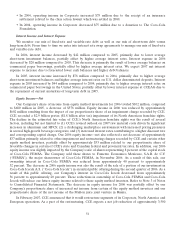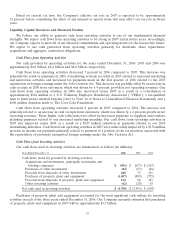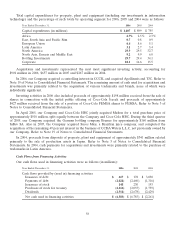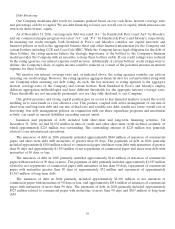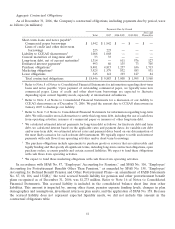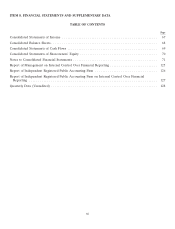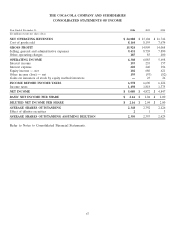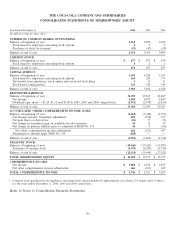Coca Cola 2006 Annual Report Download - page 64
Download and view the complete annual report
Please find page 64 of the 2006 Coca Cola annual report below. You can navigate through the pages in the report by either clicking on the pages listed below, or by using the keyword search tool below to find specific information within the annual report.The Pension Protection Act of 2006 (‘‘PPA’’) was enacted in August 2006 and established, among other
things, new standards for funding of U.S. defined benefit pension plans. One of the primary objectives of the
PPA is to improve the financial integrity of underfunded plans through the requirement of additional
contributions. The requirements of the PPA will not have a significant impact on our financial condition because,
under the provisions of the PPA, the minimum required contribution for the primary funded U.S. plan is
projected to be zero through 2017 as a result of contributions we have made to the plan since 2001. Therefore,
we did not include any amounts as a contractual obligation in the above table. We may, however, decide to make
additional discretionary contributions to our pension and other benefit plans in future years. In addition, as a
result of contributions totaling approximately $224 million in 2006 to fund a portion of our U.S. postretirement
healthcare obligation, including a contribution of $216 million to a VEBA trust, we do not expect to contribute
to our U.S. postretirement healthcare plan in 2007. We generally expect to fund all future contributions with
cash flows from operating activities.
Our international pension plans are funded in accordance with local laws and income tax regulations. We
do not expect contributions to these plans to be material in 2007 or thereafter. Therefore, no amounts have been
included in the table above.
As of December 31, 2006, the projected benefit obligation of the U.S. qualified pension plans was
$1,660 million, and the fair value of plan assets was $2,120 million. As of December 31, 2006, the projected
benefit obligation of all pension plans other than the U.S. qualified pension plans was $1,385 million, and the
fair value of all other pension plan assets was $723 million. The majority of this underfunding is attributable to
an international pension plan for certain non-U.S. employees that is unfunded due to tax law restrictions, as well
as our unfunded U.S. nonqualified pension plans. These U.S. nonqualified pension plans provide, for certain
associates, benefits that are not permitted to be funded through a qualified plan because of limits imposed by
the Internal Revenue Code of 1986. Disclosure of amounts are not included in the above table regarding
expected benefit payments for our unfunded pension plans. However, we anticipate annual benefit payments to
be in the range of approximately $25 million to $30 million in 2007 and to remain at or near this annual level for
the next several years. We can not reasonably estimate these payments for 2012 and thereafter due to the
ongoing nature of the obligations under these plans.
Deferred income tax liabilities as of December 31, 2006, were $641 million. Refer to Note 17 of Notes to
Consolidated Financial Statements. This amount is not included in the total contractual obligations table
because we believe this presentation would not be meaningful. Deferred income tax liabilities are calculated
based on temporary differences between the tax bases of assets and liabilities and their respective book bases,
which will result in taxable amounts in future years when the liabilities are settled at their reported financial
statement amounts. The results of these calculations do not have a direct connection with the amount of cash
taxes to be paid in any future periods. As a result, scheduling deferred income tax liabilities as payments due by
period could be misleading, because this scheduling would not relate to liquidity needs.
Minority interests of $358 million as of December 31, 2006, for consolidated entities in which we do not
have a 100 percent ownership interest were recorded in the consolidated balance sheet line item other liabilities.
Such minority interests are not liabilities requiring the use of cash or other resources; therefore, this amount is
excluded from the contractual obligations table.
Foreign Exchange
Our international operations are subject to opportunities and risks relating to foreign currency fluctuations
and governmental actions. We closely monitor our operations in each country and seek to adopt appropriate
strategies that are responsive to fluctuations in foreign currency exchange rates.
We use 64 functional currencies. Due to our global operations, weaknesses in some of these currencies
might be offset by strength in others. In 2006, 2005 and 2004, the weighted-average exchange rates for foreign
62




